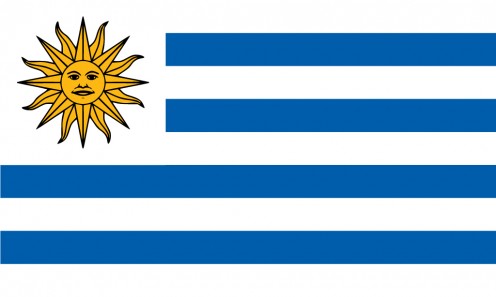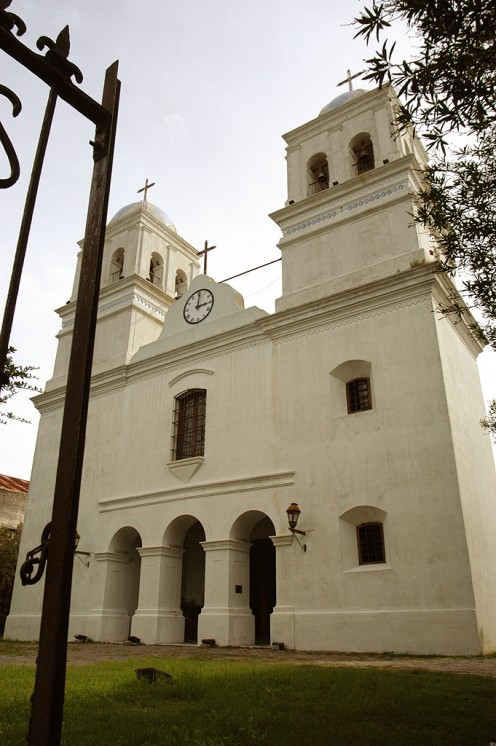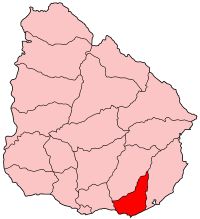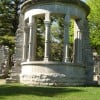Visiting San Carlos, Uruguay: distinguished ecclesiastical architecture and echoes of the Colonial era



Living history in the Maldonado department
The Colonial architecture and memories of Uruguay's Colonia del Sacramento are quite widely known, but San Carlos, a town in the south-east of the country, also deserves to be recognized for its visible, Colonial past. In particular, the church of San Carlos Borromeo , has a facade, which, when viewed from the tree-filled Plaza Artigas area of the town, is especially striking. Dating from 1763, the town was founded by Don Pedro de Cevallos , Spanish Colonial Governor.
In the Plaza Artigas, adjacent to the Church of San Carlos, there is a noted stone turret, together with a display panel.
A 1782 building in San Carlos, originally used by the Spanish Colonial authorities, today houses a regional historical museum. The museum's exhibits include arms dating from the Colonial and Independence periods.
Territorial and psychological importance of town historically
Both in Colonial and post-independence times, the location of this town may be described as important from a psychological and historical perspective. During the Colonial era — as today, only even more so — most of the population of the Banda Oriental (later, the independent country of Uruguay) was to be found along the southern coast of the country and to some, small extent along the eastern shore of the Uruguay River. San Carlos was thus the first sizeable settlement inland from this long and narrow area, itself sparsely populated. The purpose and intention of the Spanish governor and founder evidenced hopes on the part of the Colonial authorities to counter the influence of Portuguese forces from the then colony of Brazil.
The early history of the Banda Oriental recalls numerous attempts by both Spanish and Portuguese forces to defend and extend its frontier outposts in the sparsely populated borderland territory of what eventually became known as the independent country of Uruguay. This borderland background to the competing Spanish and Portuguese Colonial forces was to influence profoundly the subsequent character of the emerging Uruguayan nation.
Noted personalities
Personalities associated with Uruguay's history have connections with San Carlos include:
Colonel Leonardo Olivera (1793-1863), a military figure linked closely with Independence-era leaders, including the historically important Thirty-Three Orientals, and who took part in several militarily important battles, had close associations with San Carlos.
Archbishop Mgr. Mariano Soler (1846-1908) was born in San Carlos, and served as the first Archbishop of the Uruguayan capital, Montevideo. His tomb in Montevideo, completed 1930, was the work of the distinguished Uruguay sculptor, José Luis Zorilla de San Martín .
Interim President of Uruguay Manuel Basilio Bustamante Piris (1785-1863) was born in San Carlos, later representing its Maldonado department in the Uruguayan Senate, before serving as head of state in 1855-56.
President Francisco Antonino Vidal (1827-1889), born in San Carlos, was a medical doctor who studied in Paris; having fulfilled prominent military roles in the intermittent, mid-19th century Uruguayan Civil wars, served twice as President of Uruguay 1880 - 1882 and March - May 1886.
Also worth seeing
Maldonado department has many places worth visiting, which cannot all be adequately described here, but these include: the resort of Punta del Este, with its picturesque port area, Punta Ballena's Casapueblo museum, its nearby whale-watching point, and the Arboretum Lussich; Maldonado City, with 19th century San Fernando Cathedral and an historically important Colonial-era military barracks; the resort of Piriápolis, with its nearby Piria Castle and nature reserve; and the Sugarloaf Hill (Pan de Azúcar ); and scenic Sauce lake.
...
How to get there: LanChile flies to Montevideo , Uruguay from North American destinations including New York and Toronto . The Uruguayan airline PLUNA, which codeshares with VARIG, flies to a number of Latin American regional destinations. Car rental is available at Montevideo Carrasco International airport. Mainly seasonal flights from Buenos Aires also operate to Laguna del Sauce International Airport, which principally serves the nearby Uruguayan resort of Punta del Este . Please check with the airline or your travel agent for up to date information.
MJFenn is an independent travel writer based in Ontario, Canada.
Other of my hubpages may be of interest
- Visiting Uruguay's Punta Ballena: rocky and scenic whale watching point
Whale watching? Spectacular scenery? Historic location? Uruguay's Punta Ballena fulfils all these aspects. By the sea? by the river? Punta Ballena (literally, in Spanish: Whale Point) is... - Visiting Piria Castle: in the shadow of Uruguay's Sugarloaf Hill
Uruguay has scenic, cultural and historical treasures which deserve to be well known. One of these is Piria Castle (Spanish: Castillo de Piria ) dating from 1897, in the Maldonado Department, near the... - Visiting Montevideo's historic Cerro fortress: the looming past, and fine views
As the Portuguese sailors approached the harbour of Montevideo, now Uruguay's capital, one of them is reputed to have cried, in his language: 'Monte vid'eu !' (I see a hill). Well, apparently the name stuck. ... - Visiting Colonia, Uruguay: where the flow converges and reverberates
In the late 15th century, not long after Columbus's discovery of the Americas, Spain and Portugal, which for the next few centuries would be the principal colonial powers in much of South America, made a... - Visiting Rio and its Sugarloaf Mountain: Brazil's almost unparalleled scenery
There is a local saying that God put together all the beauty and placed it in Rio de Janeiro, Brazil. Indeed, Rio's harbour scenery is almost unparalleled. There are various Sugarloafs around the world, but...








